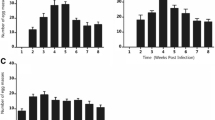Abstract
The effects of temperature on the larval development ofAngiostrongylus cantonensis inBiomphalaria glabrata were studied under controlled conditions. WhenB. glabrata were maintained at different, constant temperatures, the first-stage larvae developed to third-stage larvae between 20° and 31° C. The velocity of development to the third-stage in the snail depended on the relationship,Y=−0.1281+0.0081X (Y velocity of development;X rearing temperature). The “threshold of development” was 15.8° C and the thermal constant 123 degree-days. It is concluded that there might be a possibility ofA. cantonensis spreading to temperate regions in the world, if, in addition to the temperature, other factors allowed the completion of the life cycle of this worm.
Similar content being viewed by others
References
Alicata JE, Jindrak K (1970) Life cycle and biology. In: Angiostrongylosis in the Pacific and Southeast Asia. Anderson HH (ed) Charles C Thomas, Springfield, Illinois, pp 8–41
Ciordia H, Bizzell WE (1963) The effects of various constant temperatures on the development of the free living-stages of some nematode parasites of cattle. J Parasitol 49:60–63
Dinaburg AG (1945) The effect of low outdoor temperatures on the free-living stages of some common nematode parasites of sheep. Am J Vet Res 6:257–263
Gibbs HC, Gibbs KE (1959) The effects of temperature on the development of the free-living stages ofDochmoides stenocephala (Railliet, 1884) (Ancylostomidae: Nematoda). Can J Zool 37:247–257
Hori E, Kusui Y (1972) A survey ofAngiostrongylus cantonensis in the harbor side areas of Tokyo. 1. A survey ofAngiostrongylus cantonensis on the house rodents. Jpn J Parasitol 21:90–95 (Abstract in English)
Hori E, Miyamoto K, Ikeda O, Abe H, Nakasawa H (1969) A survey of parasitic helminths, especiallyAngiostrongylus cantonensis (Chen, 1935) Dougherty, 1946 from house rodents in the harbor side areas and overseas ships of Yokohama and Kawasaki. Jpn J Parasitol 18:258–264 (Abstract in English)
Japan Weather Association (ed) (1978–1982) Kisho Nenkan (Weather Almanac). Printing Bureau, Ministry of Finance, Tokyo
Katakura K, Oku Y, Kamiya M, Ohbayashi M (1981) Development of the mesenteric metastrongylidAngiostrongylus siamensis, inBiomphalaria glabrata, an experimental intermediate host. Jpn J Parasitol 30:23–30 (Abstract in English)
Mackerras MJ, Sandars DF (1955) The life history of the rat lung-worm,Angiostrongylus cantonensis (Chen) (Nematoda: Metastrongylidae). Aust J Zool 3:1–21
Ohbayashi M, Orihara M (1968) Discovery ofAngiostrongylus cantonensis (Chen, 1935) Dougherty, 1946 from a rat in Sapporo, northern Japan. Jpn J Parasitol 17:1–4 (Abstract in English)
Otsuru M (1978)Angiostrongylus cantonensis and angiostrongyliasis in Japan, with those of neighboring Taiwan. In: Morishita K, Kamiya Y, Matsubayashi H (eds) Progress of medical parasitology in Japan, vol. 6. Meguro Parasitological Museum, Tokyo, pp 225–274
Pflüger W (1980) Experimental epidemiology of schistosomiasis. I. The prepatent period and cercarial production ofSchistosoma mansoni inBiomphalaria snails at various constant temperatures. Z Parasitenkd 63:159–169
Sano M, Ishii A, Mochizuki H, Nakao S, Kikuchi H, Kosemura M (1977) Epidemiological survey ofAngiostrongylus cantonensis in Shimizu ship-port, Shizuoka Prefecture, Japan. Int J Zoonoses 4:111–115
Shiota T, Arizono N, Yamada M, Kurimoto H, Shimada Y, Yoshida Y (1980) Experimental infections of 13 species of Japanese freshwater mollusks withAngiostrongylus cantonensis larvae. Jpn J Parasitol 29:27–38 (Abstract in English)
Silverman PH, Campbell JA (1959) Studies on parasitic worms of sheep in Scotland. I. Embryonic and larval development ofHaemonchus contortus at constant conditions. Parasitology 49:23–38
Tanaka N, Iwanaga Y, Tsuji M (1982) Surveys of detection and serological tests ofAngiostrongylus cantonensis in rats at the harbour side area of Hiroshima. Jpn J Parasitol 31:295–301 (Abstract in English)
Tokyo Astronomical Observatory (ed) (1983) Rika Nenpyo (Science Almanac). Maruzen, Tokyo p 198
Yousif F, Ibrahim A (1978) The first record ofAngiostrongylus cantonensis from Egypt. Z Parasitenkd 56:73–80
Author information
Authors and Affiliations
Rights and permissions
About this article
Cite this article
Ishii, A.I. Effects of temperature on the larval development ofAngiostrongylus cantonensis in the intermediate host,Biomphalaria glabrata . Z. Parasitenkd. 70, 375–379 (1984). https://doi.org/10.1007/BF00927823
Accepted:
Issue Date:
DOI: https://doi.org/10.1007/BF00927823




